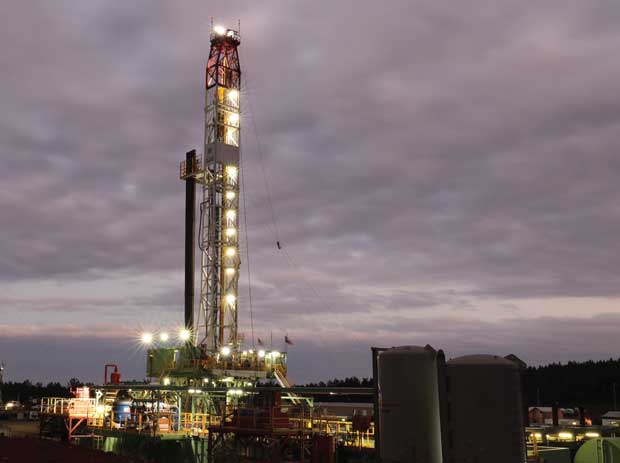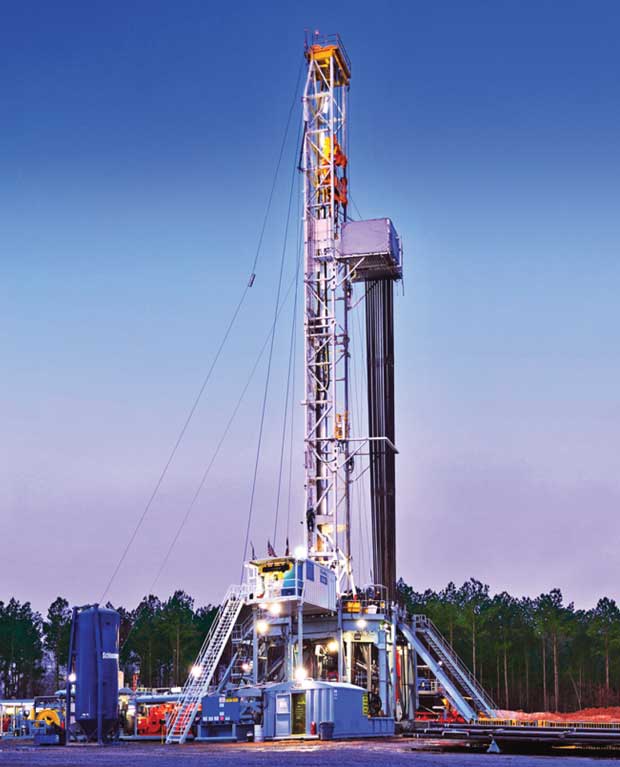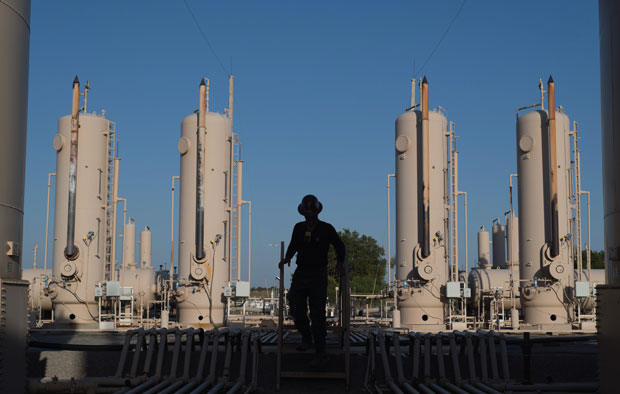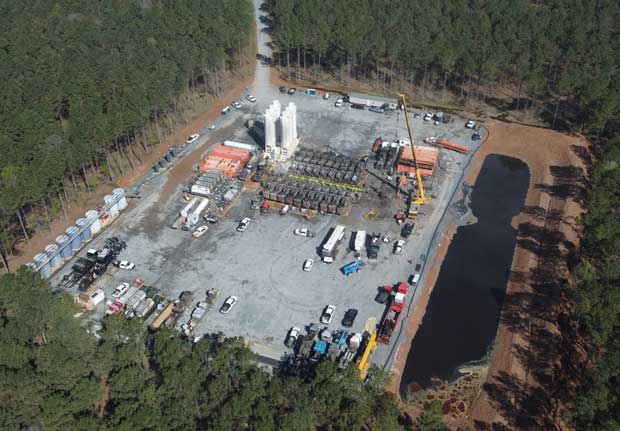
Haynesville Shale Operators Leverage Advantaged Position With LNG Exports Poised To Grow
By Danny Boyd
In December 2023, U.S. liquified natural gas exports reached an all-time monthly high of 8.6 million tons, which was up threefold from three years earlier. To feed that demand, natural gas flows to the “big seven” U.S. LNG export plants climbed to an average of 14.7 billion cubic feet a day, also a record.
But the U.S. LNG export market is only getting started. Within another three years, LNG export capacity is expected to more than double to more than 24 Bcf/d, according to the U.S. Energy Information Administration, further reinforcing the United States’ position as the largest LNG exporter on the planet.
A massive baseload export capacity is underway at Golden Pass, Corpus Christi Stage 3, Plaquemines, Port Arthur, and Rio Grande, and 11 projects have been fully approved by the Federal Energy Regulatory Commission and authorized by the Department of Energy to export LNG overseas.
Strategic positioning in the shadows of major Gulf Coast LNG terminals puts the Haynesville Shale in a unique sweet spot going forward as all the new export capacity starts coming on line, even as late-winter prices languish at Henry Hub.
“This lull in gas prices gives us a chance to get ready for when the LNG market really starts to bump up,” says Andrea Wescott Passman, chief operating officer at Aethon Energy. “We all know it is coming, regardless of what is happening politically.”
To meet European Union standards for imports, the company is lowering the methane intensity of its upstream and midstream operations, anticipating a reduction by 2028 to 0.01% (metric ton CH4/gross Mcf) across a 350,000-acre Haynesville position that extends from northern Louisiana to Robertson County, Tx., just north of Houston.
As of late February, the Dallas-based company was running seven rigs as it aggressively applies what Passman describes as an “agile design environment” to improve drilling and completion results and drive down development costs.
Connecting The Data
The use of new tools combined with artificial intelligence allows Aethon’s drilling and completions team to connect data from drilling, geosteering, logs, fiber optic, and well treatment designs and actual performance.
“We have redesigned almost every step of the well from spud through drilling, casing design and frac design,” Passman says. “Our understanding before was based on assumptions or models. Now we are getting real data and real information and it’s changing the way we think about these wells. We are seeing finding and development costs come down significantly because of it.”
Drilling days in East Texas have been cut 40% while service companies now stimulate more than seven stages a day on average compared with about five stages a day not long ago, consistently pumping 22-23 hours a day at higher rates, Passman reports. More than 10 years of drilling inventory is ranked by potential risk and reward geologically and operationally and by required capital commitment that varies across the company’s expansive acreage.
Aethon Energy is running seven rigs on its 350,000-acre Haynesville position and applying advanced technologies to optimize drilling and completion performance by redesigning almost every step, from spudding and drilling to running casing and fracturing. The results are significant reductions in drilling and stimulation times even with longer laterals and higher proppant volumes.
“Northern Louisiana does not have these monster wells, but they are super easy to get down,” she relates. “We have record wells over there that we are drilling in 11 total days right now. They do not have quite the prolific production numbers that we are seeing from Robertson County, but from a risk and return perspective, they are easy to get on line, which is the baseload of the business.”
This year, the company wants to extend average lateral lengths by 10%. Land restrictions in East Texas limit maximum length of horizontals, which extend to more than 10,000 feet in Louisiana. Aethon has pushed the bounds of coiled tubing technology and is considering jointed stick pipe as an alternative for completing longer laterals, Passman says.
On the completion side, the company remains a firm believer in applying more sand per lateral foot when it is prudent to do so. With completions varying by area, average proppant ranges between 3,500 and 4,000 pounds/foot with pump rates of 85 barrels of fluid a minute or more.
Aethon will continue to keep an eye on acquisition possibilities and has in-depth data on prospective positions, including those expected to come to market soon. In the meantime, Passman says the company will continue to apply its technical prowess.
“We know there are places we can drill where others cannot, which is a huge advantage,” she states. “We hear the horror stories out there about well losses and companies that are afraid to go into certain areas. If there is one thing I’m really proud of, it is our technical team and their ability to understand what we are getting into. They get us profitable wells with the right designs.”
Long-Term Growth
Taking advantage of well design and completion optimization, Comstock Resources is positioning itself for long-term growth in early 2024 drilling in the prolific western Haynesville Shale, which accounts for about half of its total 550,000 net-acre position.
Despite the market slowdown, Comstock Chairman and Chief Executive Officer M. Jay Allison is upbeat that the western Haynesville and other core basin assets will help the company supply its part of an extra 10 Bcf/d in new LNG demand in the next few years.
Comstock Resources is running two rigs on acreage it holds in the western Haynesville in Robertson and Leon counties in Texas. Comstock turned its eighth western Haynesville well to sales earlier this year, the Neyland No. 1, at an IP rate of 31 MMcf/d from a 10,438-foot lateral.
“We are bullish on the long-term outlook for natural gas and are growing our resource base in advantaged proximity to the Gulf Coast market,” he says.
The Frisco, Tx.-based company added 23,000 net acres in the western Haynesville in the fourth quarter and is now running two rigs on acreage it holds in Texas’ Robertson and Leon counties. The western position allows Comstock to grow inventory, now at 25 years companywide, in the near-term through the drill bit instead of having to rely on mergers and acquisitions.
“We are not inventory starved, so we do not have to do deals in the market whether gas prices are high or low to buy inventory,” Allison says.
Well results in the western region have been stellar. In early 2024, Comstock turned to sales its eighth western Haynesville well, the Neyland No. 1, at initial production rate of 31 million cubic feet a day from a 10,438-foot lateral. In mid-February, the well still had not reached its maximum IP, Allison told investors.
Three more western Haynesville wells are expected to come on line by the end of the first quarter as the company gains efficiencies from adding a well to each of its pads, says Chief Operating Officer Daniel Harrison.
Development in the west is augmented by a midstream joint venture with Quantum Capital Solutions that is unaffected by cash flow fluctuations, Allison points out. The partnership combines Comstock’s 145-mile, high-pressure pipeline and natural gas processing plant with Quantum’s commitment to provide 100% of the capital, up to $300 million, to fund system buildout.
Companywide, Comstock’s drilling and completion work replaced 109% of 1.4 billion cubic feet equivalent a day of production last year, the company says, with per-well output on operated production averaging 25 MMcf/d on 74 wells turned to sales.
The company continues to extend laterals. In the fourth quarter alone, 17 wells turned to sales had an average length of 11,873 feet, and 37% of its gross operated inventory has laterals in excess of 10,000 feet. Comstock’s longest lateral stands at 15,726 feet.
PDP-Focused Strategy
Diversified Energy Co. is buying proved, developed, producing assets to support cash flow streams that have allowed it to return to shareholders more than $800 million in the past six and a half years through dividends and share repurchases, according to President and Chief Financial Officer Brad Gray.
Its position in northern Louisiana and East Texas, including acreage in Robertson County, hosts most of the 3,000 wells in a central region that provides 40% of the 800 MMcf/d in companywide production.
“We are looking for that predictable cash flow stream and prefer lower declining assets in the mid- to high-single digits,” Gray says. “Some acquisitions in the Cotton Valley and Haynesville area have included higher declining assets primarily because they were newer wells. But we really like operating there, and the area includes some of our strongest producers.”
Diversified Energy Co. focuses on proved, developed, producing assets with slower-declining production in the mid- to high-single digits, and performing workovers to improve production and extend well life. The workovers typically cost $40,000-$50,000 per well and pay off within only a few months.
Founded in 2001, the Birmingham, Al.-headquartered company launched an initial public offering in 2017 and has since made 22 acquisitions valued at an aggregate $2.7 billion. Its work began in the pipeline-constrained Appalachian Basin. Expanding into the Haynesville allowed the company to take advantage of superior pricing for gas flowing to nearby LNG terminals and the Gulf Coast petrochemical and industrial complex, Gray recalls. On top of that, Texas and Louisiana provide favorable regulatory and legal climates that support industry growth.
In 2021, Diversified acquired East Texas Cotton Valley production from Indigo Natural Resources and later added Cotton Valley and Haynesville assets in two transactions with Quantum Energy Partners-backed Tanos Energy.
Diversified uses low-capital workovers to improve production, extend well life, and grow earnings. Gray adds that the company also focuses on improving the environmental and emissions performance of the wells it acquires from other operators, working with cutting-edge technologies and service firms. Most of the company’s assets have 50-75 years of life left, Gray mentions. Low-decline assets translate into lower capital intensity. An annual capital budget of $50 million-$55 million is devoted mostly to workovers, which typically cost $40,000-$50,000 per well. The workovers usually can be paid off within only a few months.
Several refracs on wells up to 10 years old with little intervening maintenance have yielded positive results, but the company has not settled on a predominant refrac design, according to Gray.
Undeveloped properties are gravy atop production purchases, Gray points out, reaping cash windfalls through divestitures that included a $70 million sale of undeveloped Haynesville assets to Comstock. As prices improve, he says Diversified will consider joint ventures to drill some undeveloped acreage.
Still, the PDP production model will continue to be Diversified’s calling card, as the company partners with capital firms and continues to build relationships with asset-backed securities investors, Gray relates.
“We have really positioned ourselves to be what we call the right company at the right time,” he comments. “There is a lot of focus on the development side, and we have positioned ourselves as a consolidator of choice of existing mature assets. We have an extensive inventory base we manage and feel like our model is well suited to continue to do that in multiple basins, and specifically in Louisiana and East Texas.”
Lower Cotton Valley
With much of the industry’s attention on the Haynesville/Bossier, Empresa Operating is demonstrating how modern drilling and completion technology is reinventing legacy vertical fields in northern Louisiana, where tight sand sequences of the Lower Cotton Valley are yielding oil production on par with some Permian wells.
Chairman and Chief Executive Officer Dale Bowering says the Houston company has drilled 20 horizontal wells and derisked 150 locations as it looks to expand in the Benton, Rocky Mount, Longwood and Terryville fields.
Multiple wells have tested at rates of more than 10 MMcf/d of gas and 1,000 bbl/d of oil from average lateral lengths of 6,847 feet as the company conservatively proves up and holds acreage while operating within cash flow. Still, drilling units easily can accommodate longer laterals, especially in the Benton Field north of Shreveport, according to Bowering.
“There is no reason we could not do what operators are doing in the Permian and drill three-mile laterals,” Bowering remarks. “We definitely have the real estate to do it.”
For years, Bowering, formerly with ExxonMobil and Ocean Energy, says he considered northern Louisiana to be “underexplored.” He and several colleagues together acquired a position but soon became a Haynesville player after watching next-door neighbor Chesapeake Energy discover the play in 2008. With land prices soaring, Bowering and his partners eventually divested to Chesapeake and acquired, proved up, and later divested of an Eagle Ford oil position.
By applying modern drilling and completion technology to Lower Cotton Valley tight sand sequences in legacy fields in northern Louisiana, Empresa Operating is achieving oil production rates on par with some Permian Basin wells. Multiple wells have tested at rates of more than 10 MMcf/d of gas and 1,000 bbl/d of oil from average lateral lengths of 6,847 feet.
The team continued to weigh options in legacy acreage in northern Louisiana, where land prices remained comparatively lower and other companies had found some success. Prior to being acquired by Southwestern Energy, Indigo had completed horizontal Lower Cotton Valley wells with IPs of 10 MMcf/d, proving these thin-bedded sands could produce at a high rate, Bowering recalls. Drawing on their experience in the Lower Cotton Valley, the team believed it could build on these results by drilling in the more liquids-rich areas of northern Louisianna.
The availability of local oil field products, and regional technical, professional, water transport and oil field services, combined with adequate land, make operating logistics and costs even more attractive.
Empresa’s Benton Field project is an example of an older vertical field that is now economic using modern drilling and completion technology, he notes. Discovered in 1945 and exploited vertically for decades, the Benton Field seemed ideal to test their ideas. Empresa acquired a position—which it has since expanded to 30,000 net acres across the region—and began drilling in 2017.
The Wyche 18-7H No. 1, with a vertical depth of 9,200 feet and a short 4,800-foot lateral, came in making 500 bbl/d of oil and 3 MMcf/d of rich gas from the Taylor sand. A downdip well, the Armistead 14-19H No. 1, produced 1,500 bbl/d of oil and 10 MMcf/d of from a 7,200-foot lateral.
While the Lower Cotton Valley sequences are the primary targets, Bowering says Empresa also has successfully tested two additional sections in the Middle Cotton Valley, with more target sands to come. The Davis and Justiss sands have proven to be more oil-prone along with the same four-plus gpm rich associated gas, Bowering says.
The rich gas stream provides three additional revenue sources (natural gas liquids, condensate and residue gas) to the crude income. This provides a hedge when gas or crude prices are low, Bowering points out. There is also significant carbon capture and storage potential in the Bodcaw and Cotton Valley D reservoirs. These are the thick and very porous benches discovered in the 1940s that naturally flowed hundreds of barrels of oil a day from vertical wells.
With a one-rig program, Empresa has drilled seven-eight wells annually over the past couple years, according to Bowering. Each well takes about 45 days to drill, primarily because of the hard and abrasive sand. Empresa’s technical staff works closely together to optimize wellbore placement for maximum recovery from the stacked pays.
For the primary deeper Taylor target, Empresa generally lands in a lower clean sand section and then finds sweet spots that maximizes drill bit life. With a robust frac barrier at the bottom, the hybrid frac fluids, proppant and pump rates are designed for a limited frac height while placing relatively high sand concentrations, he says. A typical frac job consists of 225,000 pounds of 40/70-mesh white sand pumped at 65 bbl/minute for each 200-foot stage, tailed in with 25,000 pounds of 40/70-mesh resin-coated proppant at 5.0 pounds/gallon.
Further industry improvements in areas such as frac plugs, pressure control, and coiled tubing bottom hole assemblies have added significant additional value by reducing the number of days between frac operations and first sales, Bowering concludes.
For other great articles about exploration, drilling, completions and production, subscribe to The American Oil & Gas Reporter and bookmark www.aogr.com.










